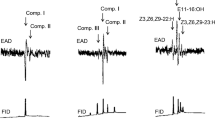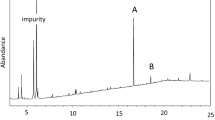Abstract
Polyunsaturated hydrocarbons (Type II pheromone components) have been reported to be synergists for unsaturated acetates, alcohols or aldehydes (Type I components) in the sex pheromones of several species of Lepidoptera. However, there is some debate over whether the active components are the hydrocarbons themselves or more volatile degradation products. Extracts of pheromone glands of adult females of the cone moth, Dioryctria mendacella (Lepidoptera: Pyralidae), contain (Z,E)-9,11-tetradecadienyl acetate (ZE9,11–14:Ac) and at least ten times as much (Z,Z,Z,Z,Z)-3,6,9,12,15-pentacosapentaene (ZZZZZ3,6,9,12,15–25:H). The former elicits a strong electroantennogram response from males while no response could be recorded to the latter. In field trapping tests, both compounds were individually unattractive to male D. mendacella moths, but blends of the two compounds containing at least a 10:1 ratio of ZZZZZ3,6,9,12,15–25:H : ZE9,11–14:Ac were highly attractive. The relatively involatile hydrocarbon was shown to be released from the dispensers used and no significant degradation could be detected. Furthermore, blends of ZE9,11–14:Ac and analogs of ZZZZZ3,6,9,12,15–25:H with fewer carbons and/or double bonds that might be expected to produce similar degradation products to ZZZZZ3,6,9,12,15–25:H were unattractive. This indicated a specific response to the hydrocarbon itself, further substantiated by the observation that related hydrocarbons did not interfere with the activity of ZZZZZ3,6,9,12,15–25:H. Thus a three-step conversion of fish oil was used to produce a blend of unsaturated hydrocarbons containing ZZZZZ3,6,9,12,15–25:H as the major component, albeit only 30% of the total, and a blend of this material with ZE9,11–14:Ac was as attractive to male D. mendacella moths as blends with an equivalent amount of the purified material. This mixture of unsaturated hydrocarbons is much cheaper to produce than the pure pentaene, and may be useful in lures for other species using these compounds. Dioryctria mendacella is a major constraint to production of edible pine kernels throughout the Mediterranean region. Pheromone traps will provide a means to improve monitoring of seasonal flight patterns and changes in population abundance of this pest.






Similar content being viewed by others
References
Ando T, Inomate SI, Yamamoto M (2004) Lepidopteran sex pheromones. In: Schulz S (ed) The chemistry of pheromones and other semiochemicals. Springer, Berlin, pp 51–96
Bartelt RJ, Jones RL (1983) (Z)-10-Nonadecenal: a pheromonally active air oxidation product of (Z,Z)-9,19-dienes in the yellow-headed spruce sawfly. J Chem Ecol 9:1333–1342
Boivin T, Auger-Rozenberg M-A (2016) Native fruit, cone and seed insects in the Mediterranean Basin. In: Insects and diseases in Mediterranean Forest systems. eds T.D. Paine and F. Lieutier. Springer, The Netherlands. pp. 47–88
Bracalini M, Benedetelli S, Croci F, Terreni P, Tiberi R, Panzavolta T (2013) Cone and seed pests of Pinus pinea: assessment and characterization of damage. J Econ Entomol 106:229–234
Cabrera A, Eiras A, Gries G, Gries R, Urdaneta N, Miras B, Badji C, Jaffe K (2001) Sex pheromone of tomato fruit borer, Neoleucinodes elegantalis. J Chem Ecol 27:2097–2107
Cork A, Beevor PS, Gough AJE, Hall DR (1990) Gas chromatography linked to electroantennography: a versatile technique for identifying insect semiochemicals. In: McCaffery AR, Wilson ID (eds) Chromatography and isolation of insect hormones and pheromones. Plenum Press, New York, pp 271–279
El-Sayed AM (2016) The Pherobase: database of pheromones and semiochemicals http://www.pherobase.com
El-Sayed AM, Gibb AR, Mitchell VJ, Manning L-A M, Revell J, Thistleton B, Suckling DM (2013) Identification of the sex pheromone of Conogethes pluto: a pest of Alpinia. Chemoecology 23:93–101
Gibb AR, Pinese B, Tenakanai D, Kawi AP, Bunn B, Ramankutty P, Suckling DM (2007) (Z)-11-Hexadecenal and (3Z,6Z,9Z)-tricosatriene: sex pheromone components of the red banded mango caterpillar Deanolis sublimbalis. J Chem Ecol 33:579–589
Gordo J, Mutke S, Gil L (1997) Variabilidad en la producción de fruto de Pinus pinea L. en la provincia de Valladolid. I Congreso Forestal Hispano-Luso/II Congreso Forestal Español. Pamplona June 1997. Abstracts, 327-332
Hall DR, Beevor PS, Lester R, Poppi RG, Nesbitt BF (1975) Synthesis of the major sex pheromone of the Egyptian cotton leafworm, Spodoptera littoralis (Boisd.) Chem Ind 216–217
Honda H, Yamasaki R, Sumiuchi Y, Uehara T, Matsuyama S, Ando T, Naka H (2015) Hybrid sex pheromones of the hibiscus flower-bud borer, Rehimena surusalis. J Chem Ecol 41:1043–1049
Innocenti M, Tiberi R (2002) The cone and seed pests of Pinus pinea L. in Central Italy. Redia 85:21–28
Jaffe K, Miras B, Cabrera A (2007) Mate selection in the moth Neoleucinodes elegantalis: evidence for a supernormal chemical stimulus in sexual attraction. Anim Behav 73:727–734
Karsholt O, van Nieukerken EJ, Erik J (2014) Fauna Europea: Dioryctria mendacella. In: Fauna Europaea - all European animal species on the web. eds Y. de Jong et al. . Biodiversity Data Journal 2. e4034
Knölke S (2007) A revision of the European representatives of the microlepidopteran genus Dioryctria Zeller, 1846 (Insecta: Lepidoptera: Pyralidae: Phycitinae). Ludwig Maximilians-Universität München, Munich
Leal WS, Parra-Pedrazzoli AL, Kaissling K-E, Morgan TI, Zalom FG, Pesak DJ, Dundulis EA, Burks CS, Higbee BS (2005) Unusual pheromone chemistry in the navel orangeworm: novel sex attractants and a behavioral antagonist. Naturwissenschaften 92:139–146
Löfstedt C, Svensson GP, Jirle EV, Rosenberg O, Roques A, Millar JG (2012) (3Z,6Z,9Z,12Z,15Z)-Pentacosapentaene and (9Z,11E)-tetradecadienyl acetate: sex pheromone of the spruce coneworm Dioryctria abietella (Lepidoptera: Pyralidae). J Appl Entomol 136:70–78
Millar JG, Grant GG, McElfresh JS, Strong W, Rudolph C, Stein JD, Moreira JA (2005) (3Z,6Z,9Z,12Z,15Z)-Pentacosapentaene, a key pheromone component of the fir coneworm moth, Dioryctria abietivorella. J Chem Ecol 31:1229–1234
Miller DR, Millar JG, Mangini A, Crowe CM, Grant GG (2010) (3Z,6Z,9Z,12Z,15Z)-Pentacosapentaene and (Z)-11-hexadecenyl acetate: sex attractant blend for Dioryctria amatella (Lepidoptera: Pyralidae). J Econ Entomol 103:1216–1221
Mutke S, Piqué M, Calama R (2013) AGROPINE 2011 Meeting conclusions. In: Mutke S, Piqué M, Calama R (eds) Mediterranean stone pine for agroforestry. Options Méditerranéennes Série A. Séminaires Méditerranéens; n. 105. CIHEAM/FAO/INIA/IRTA/CESEFOR/CTFC, Zaragoza, p 111–112
Strong WB, Millar JG, Grant GG, Moreira JA, Chong JM, Rudolph C (2008) Optimization of pheromone lure and trap design for monitoring the fir coneworm, Dioryctria abietivorella. Entomol Exp Appl 126:67–77
The R Development Core Team (2011) R: a language and environment for statistical computing. R Foundation for Statistical Computing, Vienna ISBN: 3-900051- 07-0
UK CAB International (1991) Distribution Maps of Plant Pests. CAB International, Wallingford Map 520
Wang S, Zhang A (2007) Facile and efficient syntheses of (3Z,6Z,9Z)-3,6,9-nonadecatriene and homologues: pheromone and attractant components of Lepidoptera. J Agric Food Chem 55:6929–6932
Xiao W, Matsuyama S, Ando T, Millar JG, Honda H (2012) Unsaturated cuticular hydrocarbons synergize responses to sex attractant pheromone in the yellow peach moth, Conogethes punctiferalis. J Chem Ecol 38:1143–1150
Yan Q, Vang LV, Khanh CNQ, Naka H, Ando T (2014) Reexamination of the female sex pheromone of the sweet potato vine borer moth: identification and field evaluation of a tricosatriene. J Chem Ecol 40:590–598
Acknowledgements
We would like to acknowledge the field assistance and support provided A. Ponce, F.J. Gordo, the forest officers at the Castilla y León Forest Service in Valladolid and the crew at Castilla y León Forest Health Center (Calabazanos, Palencia). G. Álvarez-Baz assisted with the statistical analyses. This work has been financed by grants by the Diputación de Valladolid (PROPINEA project) and by the Castilla y León Government.
Author information
Authors and Affiliations
Corresponding author
Electronic supplementary material
ESM 1
(PDF 96 kb)
Rights and permissions
About this article
Cite this article
Hall, D.R., Farman, D., Domínguez, J.C. et al. Female Sex Pheromone of the Cone Moth, Dioryctria mendacella: Investigation of Synergism between Type I and Type II Pheromone Components. J Chem Ecol 43, 433–442 (2017). https://doi.org/10.1007/s10886-017-0846-8
Received:
Revised:
Accepted:
Published:
Issue Date:
DOI: https://doi.org/10.1007/s10886-017-0846-8




